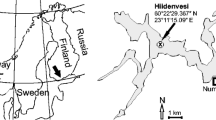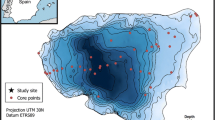Abstract
Eutrophication is the most common water quality issue affecting freshwaters worldwide. Paleolimnological approaches have been used in temperate regions to track eutrophication over time, placing changes in historical context. Diatoms (Bacillariophyta) have a direct physiological response to changes in nutrients and are effective indicators of lake trophic status. Chironomids (Diptera) have also been used to track nutrient conditions; however, given that nutrients and oxygen are often tightly linked, it is difficult to disentangle which variable is driving shifts in assemblages. Here, we analyze chironomid and diatom remains in sediments from sewage-impacted ponds in the High Arctic. These ponds have the unusual characteristics of elevated nutrient and oxygen concentrations, unlike those of typical eutrophic lakes where deepwater oxygen is often depleted. Our data show that while diatom assemblages responded to changing nutrients, no concomitant changes in chironomid assemblage composition were recorded. Furthermore, the dominance of oligotrophic, cold stenothermic chironomid taxa, and lack of so-called “eutrophic” species in the eutrophic sewage ponds suggests that oxygen, not nutrients, structures chironomid assemblages at these sites.









Similar content being viewed by others
References
Antoniades, D., M. S. V. Douglas & J. P. Smol, 2003. Comparative physical and chemical limnology of two Canadian High Arctic regions: alert (Ellesmere Island, NU) and Mould Bay (Prince Patrick Island, NWT). Archiv für Hydrobiologie 158: 485–516.
Antoniades, D., P. B. Hamilton, M. S. V. Douglas & J. P. Smol, 2008. Diatoms of North America: the freshwater floras of Prince Patrick, Ellef Ringnes, and Northern Ellesmere Islands from the Canadian Arctic Archipelago. Iconographia Diatomologica, 17. A.R.G. Gantner/Verlag, Ruggell, Liechtenstein.
Antoniades, D., N. Michelutti, R. Quinlan, J. M. Blais, S. Bonilla, M. S. V. Douglas, R. Pienitz, J. P. Smol & W. F. Vincent, 2011. Cultural eutrophication, anoxia, and ecosystem recovery in Meretta Lake, High Arctic Canada. Limnology and Oceanography 56: 639–665.
Appleby, P. G. & F. Oldfield, 1978. The calculation of 210Pb dates assuming a constant rate of supply of unsupported 210Pb to the sediment. Catena 5: 1–8.
Battarbee, R. W., L. Carvalho, V. G. Jones, R. J. Flower, et al., 2001. Diatoms. In Last, W. M. & J. P. Smol (eds), Tracking Environmental Change Using Lake Sediments. Volume 3: Terrestrial, Algal, and Siliceous Indicators. Kluwer, Dordrecht: 155–202.
Blais, J. M., L. E. Kimpe, D. McMahon, B. E. Keatley, M. L. Mallory, M. S. V. Douglas & J. P. Smol, 2005. Arctic seabirds transport marine-derived contaminants. Science 309: 445.
Brodersen, K. P. & C. Lindegaard, 1999. Classification, assessment and trophic reconstruction of Danish lakes using chironomids. Freshwater Biology 42: 143–157.
Brodersen, K. P. & R. Quinlan, 2006. Midges as palaeoindicators of lake productivity. Quaternary Science Reviews 25: 1995–2012.
Brodersen, K. P., O. Pedersen, C. Lindegaard & K. Hambuger, 2004. Chironomids (Diptera) and oxy-regulatory capacity: an experimental approach to paleolimnological interpretation. Limnology and Oceanography 49: 1549–1559.
Brooks, S. J., H. Bennion & J. B. Birks, 2001. Tracing lake trophic history with a chironomid total phosphorus inference model. Freshwater Biology 46: 513–533.
Brooks, S. J., P. G. Langdon & O. Heiri, 2007. The Identification and Use of PalaeArctic Chironomidae Larvae in Palaeoecology. QRA Technical Guide No. 10. Quaternary Research Association, London.
Brundin, L., 1949. Chironomiden und andere Bodentiere der südschwedischen urgebirgsseen. Report/Institute of Fresh-Water Research Drottningholm 30: 1–914.
Brundin, L., 1956. Die bodenfaunistischen Seetypen un ihre Anwenbarkeit auf die Südhalbkugel. Zugleich eine Theorie der produktionsbiologischen Bedeutung der glazialen Erosion. Report/Institute of Fresh-water Research Drottningholm 37: 186–235.
Czeczuga, B., 1960. Haemoglobin content of the larvae of Tendipes f l. plumosus L. from various levels of bed sediment. Nature 186: 484.
Douglas, M. S. V. & J. P. Smol, 1994. Limnology of high arctic ponds (Cape Herschel, Ellesmere Island, N.W.T.). Archiv für Hydrobiologie 131: 401–434.
Douglas, M. S. V. & J. P. Smol, 2000. Eutrophication and recovery in the High Arctic: Meretta Lake (Cornwallis Island, Nunavut, Canada) revisited. Hydrobiologia 431: 193–204.
Eggermont, H. & O. Heiri, 2012. The chironomid–temperature relationship: expression in nature and palaeoenvironmental implications. Biological Reviews 87: 430–456.
Environment Canada, 1979. Analytical Methods Manual. Water Quality Branch, Inland Water Directorate, Ottawa, ON.
Environment Canada, 2012. Canadian Climate Normals 1971–2000 [Internet]. Accessed 2012 May 16. Available from http://www.climate.weatheroffice.gc.ca/climate_normals/results_e.html?stnID=1776&autofwd=1.
Glew, J. R., 1988. A portable extruding device for close interval sectioning of unconsolidated core samples. Journal of Paleolimnology 1: 235–239.
Hall, R. I. & J. P. Smol, 2010. Diatoms as indicators of lake eutrophication. In Smol, J. P. & E. F. Stoermer (eds), The Diatoms: Applications for the Environmental and Earth Sciences. Cambridge University Press, Cambridge: 122–151.
Hamburger, K., P. C. Dall & C. Lindegaard, 1995. Energy metabolism of Chironomus anthracinus (Diptera, Chironomidae) under laboratory and field conditions. Hydrobiologia 297: 187–200.
Heinis, F., J.-P. Sweerts & E. Loopie, 1994. Micro-environment of chironomids larvae in the littoral and profundal zones of Lake Maarsseveen I, The Netherlands. Fundamental Applied Limnology 124: 173–289.
Int Panis, L., B. Godeeris & R. F. Verheyen, 1995. On the relationship between oxygen microstratification in a pond and the spatial distribution of the benthic chironomid fauna. In Cranston, P. (ed.), Chironomids: From Genes to Ecosystems. CSIRO Publications, Melbourne: 323–328.
Keatley, B. E., M. S. V. Douglas, J. M. Blais, M. L. Mallory & J. P. Smol, 2009. Impacts of seabird-derived nutrients on water quality and diatom assemblages from Cape Vera, Devon Island, Canadian High Arctic. Hydrobiologia 61: 191–205.
Keatley, B. E., J. M. Blais, M. S. V. Douglas, I. Gregory-Eaves, M. L. Mallory, N. Michelutti & J. P. Smol, 2011. Historical seabird population dynamics and their effects on Arctic pond ecosystems: a multi-proxy paleolimnological study from Cape Vera, Devon Island, Arctic Canada. Fundamental Applied Limnology 179: 51–66.
Michelutti, N., M. S. V. Douglas & J. P. Smol, 2002. Tracking recent recovery from eutrophication in a High-Arctic lake (Meretta Lake, Cornwallis Island, Nunavut, Canada) using fossil diatom assemblages. Journal of Paleolimnology 28: 377–381.
Michelutti, N., M. S. V. Douglas & J. P. Smol, 2003. Diatom response to recent climatic change in a high arctic lake (Char Lake, Cornwallis Island, Nunavut). Global and Planetary Change 38: 257–271.
Michelutti, N., M. H. Hermanson, J. P. Smol, P. J. Dillon & M. S. V. Douglas, 2007a. Delayed response of diatom assemblages to sewage inputs in an Arctic lake. Aquatic Science 69: 523–533.
Michelutti, N., M. S. V. Douglas & J. P. Smol, 2007b. Evaluating diatom community composition in the absence of marked limnological gradients in the High Arctic: a surface sediment calibration set from Cornwallis Island (Nunavut, Canada). Polar Biology 30: 1459–1473.
Michelutti, N., M. L. Mallory, J. M. Blais, M. S. V. Douglas & J. P. Smol, 2011. Chironomid assemblages from seabird-affected high Arctic ponds. Polar Biology 34: 799–812.
Quinlan, R. & J. P. Smol, 2001a. Setting minimum head capsule abundance and taxa deletion criteria in chironomid-based inference models. Journal of Paleolimnology 26: 327–342.
Quinlan, R. & J. P. Smol, 2001b. Chironomid-based inference models for estimating end-of-summer hypolimnetic oxygen from south-central Ontario lakes. Freshwater Biology 46: 1529–1551.
Quinlan, R., J. P. Smol & R. I. Hall, 1998. Quantitative inferences of past hypolimnetic anoxia in south-central Ontario lakes using fossil midges (Diptera: Chironomidae). Canadian Journal of Fisheries and Aquatic Sciences 55: 587–596.
Quinlan, R., M. S. V. Douglas & J. P. Smol, 2005. Food web changes in arctic ecosystems related to climate warming. Global Change Biology 11: 1381–1386.
Schindler, D. W., J. Kalff, H. E. Welch, G. J. Brunskill, H. Kling & N. Kritsch, 1974. Eutrophication in the High Arctic – Meretta Lake, Cornwallis Island (75° N Lat.). Journal of Fisheries Research Board of Canada 31: 647–662.
Scholz, F. & I. Zerbst-Boroffka, 1998. Environmental hypoxia affects osmotic and ionic regulation in freshwater midge-larvae. Journal of Insect Physiology 44: 427–436.
Smol, J. P., 2010. The power of the past: using sediments to track the effects of multiple stressors on lake ecosystems. Freshwater Biology 55(Suppl. 1): 43–59.
Smol, J. P. & M. S. V. Douglas, 2007a. From controversy to consensus: making the case for recent climatic change in the Arctic using lake sediments. Frontiers in Ecology and the Environment 5: 466–474.
Smol, J. P. & M. S. V. Douglas, 2007b. Crossing the final ecological threshold in high Arctic ponds. Proceedings of the National Academy of Sciences 104: 12395–12397.
Smol, J. P., A. P. Wolfe, H. J. B. Birks, M. S. V. Douglas, V. J. Jones, A. Korhola, R. Pienitz, K. Rühland, S. Sorvari, D. Antoniades, S. J. Brooks, M. Fallu, M. Hughes, B. E. Keatley, T. E. Laing, N. Michelutti, L. Nazarova, N. Nyman, A. M. Paterson, B. Perren, R. Quinlan, M. Rautio, E. Saulnier-Talbot, S. Siitonen, N. Solovieva & J. Weckstrom, 2005. Climate driven regime shifts in the biological communities of arctic lakes. Proceedings of the National Academy of Sciences of the United States of America 102: 4397–4402.
Spaulding, S. & M. Edlund, 2009. Fistulifera. In: Diatoms of the United States. Retrieved 12 October 2012. Available from http://westerndiatoms.colorado.edu/taxa/genus/Fistulifera.
Stewart, E. M., N. Michelutti, J. M. Blais, M. L. Mallory, M. S. V. Douglas & J. P. Smol, 2013. Contrasting the effects of climate, nutrient, and oxygen dynamics on subfossil chironomid assemblages: a paleolimnological experiment from eutrophic High Arctic ponds. Journal of Paleolimnology 49: 205–219.
Thienemann, A., 1920. Untersuchungen über die Bziehungen zwischen dem Sauerstoffgehaly des Wassers und der zusammensetzung der Fauna in norddeutschen Seen. Archiv für Hydrobiologie 12: 1–65.
Thienemann, A., 1954. Chironomus. Leben, Verbreitung und wirtschaftliche Bedeutung der Chironomiden. Binnengewässer 20: 1–834.
Walker, I. R., 2001. Midges: Chironomidae and related Diptera. In Smol, J. P., H. J. B. Birks & W. M. Last (eds), Tracking Environmental Change Using Lake Sediments, Vol. 4: Zoological Indicators. Kluwer Academic Publishers, Dordrecht: 43–66.
Weber, R. E., 1980. Functions of invertebrate haemoglobins with special reference to adaptations to environmental hypoxia. American Zoologist 20: 79–101.
Wolfe, A. P., G. F. Miller, C. A. Olsen, S. L. Forman, P. T. Doran & S. U. Holmgren, 2004. Geochronology of high latitude lake sediments. In Pienitz, R., M. S. V. Douglas & J. P. Smol (eds), Developments in Paleoenvironmental Research, Vol. 8: Long-Term Environmental Change in the Arctic and Antarctic lakes. Springer, Dordrecht: 19–52.
Acknowledgements
This work was made possible because of the logistical and financial support provided by the Natural Science and Engineering Research Council (NSERC), Indian and Northern Affairs Canada (NSTP), Natural Resources Canada, the Polar Continental Shelf Program (PCSP), and the W. Garfield Weston Foundation. We would like to thank Xiaowa Wang and the National Laboratory for Environmental Testing (NLET, Burlington, ON) for water chemistry analyses. We would also like to thank our colleagues at the Paleoecological Environmental Assessment and Research Laboratory (Queen’s University, Kingston, Canada) for advice and support. Finally, we would like to thank two anonymous reviewers whose comments strengthened our manuscript.
Author information
Authors and Affiliations
Corresponding author
Additional information
Handling editor: Jasmine Saros
Electronic supplementary material
Below is the link to the electronic supplementary material.
10750_2013_1667_MOESM2_ESM.docx
Appendix 2 Chironomid species presence (X) or absence in the surface sediments of the years listed at the top of the table for the sewage ponds near Resolute Bay, Cornwallis Island, Nunavut (DOCX 16 kb)
10750_2013_1667_MOESM3_ESM.docx
Appendix 3 Species abbreviations used in Fig. 9 listed alphabetically by proxy (DOCX 14 kb)
Rights and permissions
About this article
Cite this article
Stewart, E.M., McIver, R., Michelutti, N. et al. Assessing the efficacy of chironomid and diatom assemblages in tracking eutrophication in High Arctic sewage ponds. Hydrobiologia 721, 251–268 (2014). https://doi.org/10.1007/s10750-013-1667-6
Received:
Revised:
Accepted:
Published:
Issue Date:
DOI: https://doi.org/10.1007/s10750-013-1667-6




